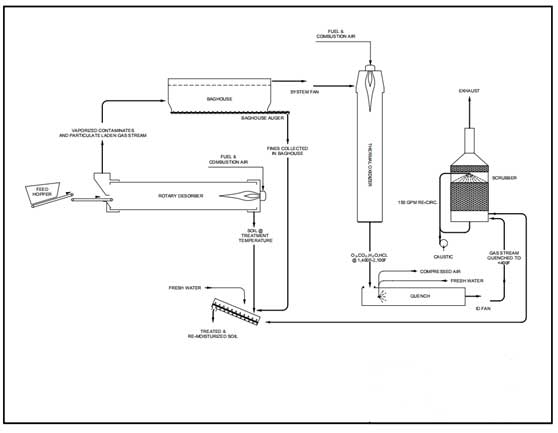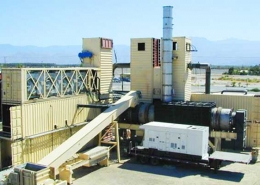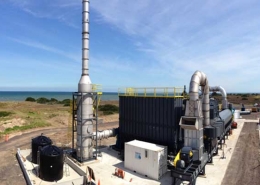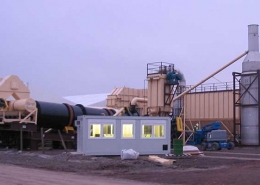Rotary Contaminated Soil Dry Distillation Furnace Production Line
Soil remediation description
LCDRI is a complete system manufacturer for thermal soil remediation. We build and design all our systems, it’s what we do. Our rotary thermal desorption unit are the center of all our plants. Our LCDRI Drying Systems are one of the most versatile industrial dryers on the market. Our modular approach allows you to pick the dryer size, flight arrangement, burner and air pollution control equipment to best suit your unique project. LCDRI Drying Systems are built to rigorous safety and performance standards because they are 100% designed, manufactured and tested in the China .
Customized for you
We customize every system. For this reason LCDRI’s engineering team designs each system and does shop drawings in house. Typical systems include:
- properly sized dryer;
- appropriate feed equipment (feed bins, conveyors, weigh conveyors, augers);
- air pollution control equipment (baghouses, cyclones).
Automatic Control Equipment
All of these equipment pieces are designed and built more robust than required to make a complete and balanced system. Capacity of our plants is from 10 tons per hour to 400 tons per hour.LCDRI has installed over 80 complete plants around the world meeting stringent electrical, air pollution control and safety codes in Western Europe and all of North and South America. Our goal is to exceed our customer’s needs for many years.
CONTACT US
Soil remediation process
Organic contaminated soil enters the roasting chamber through the material inlet of the conveyor and closes the material inlet. Clean fuel produces hot gas in the combustion furnace. The temperature of hot gas is 600-750 C. After the hot gas is discharged from the outlet of the combustion furnace, it enters the heating passage through the heating passage inlet. Rotary kiln rotates to drive the roasting furnace wall to rotate, though indirect heating ,the temperature of organic polluted soil in soasting room reached more than 550℃ and heated continuously for 6-9 minutes. The organic pollutants in the soil were separated by evaporation.
During the heating process, the isolated organic pollutants and water are discharged from the outlet of the contaminated gas, the combustion furnace is completely decomposed and burned by the gas inlet of the combustion furnace, the flue gas and hot air produced after combustion are discharged from the hot outlet of the combustion furnace, and the flue gas and hot air are indirectly heated to the organic polluted soil after the heat, From the heating channel out of the hot mouth discharge, through the bag dust collector inlet enter into the bag dust collector.
The bag dust collector separates the soil particles from the flue gas,the flue gas is discahrged from the flue gas outlet of the bag dust collector, it enters the chimney through the exhaust fan,and is discharged after being treated by the acid removal device. The soil particles discharged from the outlet of the soil particles that are recovered at the bottom of the bag filter .
Rehabilitated soil in roasting chamber is discharged from the outlet of material, and is fed into the rotary cooler with feed-gas separation through the inlet of the cooler. The rotary cooler makes the heated soil heat exchanged fully with the cold air. The generated hot air is discharged from the hot air outlet of the cooler, and is used as secondary hot air through the gas inlet of the combustion furnace. The soil after repairing and cooling is discharged from the outlet of the cooler. And recycly it.
Advantage
- It can completely degrade a variety of refractory organic pollutants, and the treatment process is simple;
- modular design is easy to move and transport, which can deal with contaminated soil inside contaminated sites,and it ensure that pollutants do not Sinotrans and reduce the risk of two pollution;
- the operation cost of the project is lower than that of the similar equipment abroad and the disposal efficiency is high;
- Adopting indirect heating desorption, with no direct contact between hot air and soil,, low energy consumption and high desorption efficiency, which can be completely repaired soil remediation, and the separated organic pollutants into the combustion furnace is enriched oxygen complete combustion decomposition;
- The amount of exhaust gas is small, there is no secondary pollution, energy saving and efficiency, and low investment;
- It belongs to a closed circulation system, which has the characteristics of high heat exchange efficiency, low energy consumption and low pollution;
- The floor space is small, the investment is small, the equipment used is simple, and it can be mobile;
- The equipment is stable, the operation process is simple and convenient, the soil repair efficiency is high, and a lot of time is saved;
- The use of automatic control and real-time monitoring reduces the requirements on the number and proficiency of operators, and the degree of automation is high; it can effectively avoid the leakage of pollutants during the repair process;
- Ensure that the harmful flue gas has enough residence time in the combustion chamber, so as to eliminate the two pollution occurring in the soil remediation process. The operation cost is lower than that of the landfill and direct combustion, and the repaired soil can be achieve the purpose of re-use, achieving the goal of high efficiency, low energy consumption, easy operation and environmental protection.
Soil remediation application
The Relocation site of Petrochemical Plant coking plant, steel mills, Insecticide factory , gas station in the city , Solid waste accumulation in mining and industrial dust pollution,Soil pollution caused by informal garbage, such as a number of reasons, cause a large amount of organic matter pollution, heavy metal pollution and legacy of organic matter and heavy metals compound pollution.The harmful and active substances in the soil exceed the self-purification ability of the soil, resulting in the physical, chemical and biological changes of the soil.
To change this kind of soil pollution in the city for residential, commercial, schools, medical and other public lands, seriously affect the living on this land, therefore, must be in front of the land use, repair the land of this kind of pollution.
Programme of the Thermal Desorption Unit
① Thermal Desorption Unit (Drill Cuttings, 5 TPH)
LCDRI Drying Systems personnel designed and commissioned a plant for a client in Nigeria to remediate drill cuttings through an indirect Rotary Thermal Desorption Unit with Vapor Recovery. Control technology was designed around EPA standards in order to ensure no negative environmental impacts occur from running the system.
The system was designed to process 5 TPH of drill cuttings. The system uses No. 2 fuel oil and recovered oil from the remediation process, providing a self-sufficient solution to the client.
Equipment Included
• Four (4) 2 MMBtu/hr Burner zones
• Rotary Thermal Desorption Kiln
• Quench Tower
• Air Cooled Heat Exchanger
• Shell & Tube Heat Exchanger
• Chiller
• Knock Out Pot
• Blower
• Thermal Oxidizer
• Oil/Water Separator
LCDRI Thermal Desorption Unit Specifications
|
Model |
LCDRI-35A |
|
Capacity |
3.5 to 5.0 Tons/Hour |
|
TPH on treated Solids |
0.3-1 % |
|
Total Installed Power |
About 150Kw |
|
Power Consumption |
About 100KW |
|
Burner Type |
Diesel or Natural Gas made in Italy |
|
No. of Burners |
6 (Two font burners, four side burners) |
|
Fuel Consumption |
About 130Kg/Hour Diesel |
|
Ambient Temp. |
0-45 C degree |
|
BS&W in Oil recovered |
<1% |
② Thermal Desorption Unit (Drill Cuttings, 10 TPH)
LCDRI Drying Systems personnel commissioned a plant to a client in Argentina who plans to remediate drill cuttings and other contaminated soils in a mobile engineering lab in an indirect Rotary Thermal Desorption Unit with Vapor Recovery. This effort is aimed to reduce landfilling of drill cuttings and recycle diesel based drilling fluids. Control technology was designed around EPA standards to ensure no negative environmental impacts from running the system.
The system was designed to process 10 TPH of drill cuttings. The system uses oil fired burners
Equipment Included:
• 24 MMBtu/hr. Burners
• 72″ D x 58′ L Indirect Fired Rotary Kiln
• Clay Feeder
• Incline Screw Feed Conveyor
• Kiln Screw Conveyor
• Rotary Airlock
• Incline Screw Discharge Conveyor
• Quench Tower
• Air Cooled Heat Exchanger
• Carrier Air Cooled Chiller
• Knock Out Pot
• Double Pipe Heat Exchanger
• Oil/Water Separator
③ Thermal Desorption Unit (Drill Cuttings, 0.5 TPH)
LCDRI Drying Systems personnel commissioned a plant to a client in Romania to remediate drill cuttings and other contaminated soils in a mobile indirect Rotary Thermal Desorption Unit with Vapor Recovery. This effort is aimed to reduce landfilling of drill cuttings and recycle diesel based drilling fluids. Control technology was designed around EPA standards to ensure no negative environmental impacts from running the system.
Equipment Included
• Primary Burner
• 24″ D x 15′ L Indirect Fired SS Rotary Kiln
• Quench Tower
• Air Cooled Heat Exchanger
• Air Cooled Chiller
• Shell & Tube Heat Exchanger/Coiled Heat Exchanger
• Knock Out Pot
• Oil/Water Separator
Tank bottoms detailed specifications for soil remediation
Basis of Design – Throughput Calculations Based on – 50% Solids, 30% Hydrocarbons, 20% Water
|
Model |
Tonnage |
Drum |
Portable |
|
LCDR315 |
1 TPH |
3×15 |
YES |
|
LCDR420 |
2 TPH |
4×20 |
YES |
|
LCDR430 |
3 TPH |
4×30 |
YES |
|
LCDR525 |
5 TPH |
5×25 |
YES |
|
LCDR630 |
7.5 TPH |
6×30 |
NO |
|
LCDR735 |
10 TPH |
7×35 |
NO |
* Varying capacities and feed consistency will change product capacity.
Detailed parameters of soil contamination by drilling cuttings
Additional Options
|
Heat Recovery |
Using heat from a thermal oxidizer allows for preheating of combustion air in burners. This option can save up to 25% of fuel consumption in the system |
|
Waste Oil Burner System |
An additional waste oil burner system consists of waste oil burners, fuel train, filters, and waste oil storage tank with heating elements. Reusing recovered oil as fuel will typically reduce fuel cost. |
|
Discharge Quench |
The stack on the discharge auger can be fitted with spray nozzles along the length of the stack. The quench spray removes excess particles from the gas stream before discharging steam into the atmosphere. |
|
Nitrogen Generator |
The swing adsorption nitrogen generator, with a nitrogen storage tank purges the system during start-up and shutdown. Nitrogen is also utilized during the process in order to keep O2 levels below the pre-detemined percent. |
|
Portable |
A portable option is available, placing the entire system on trailers or skids. This option is only available for specific models. |

-845x321.jpg)



